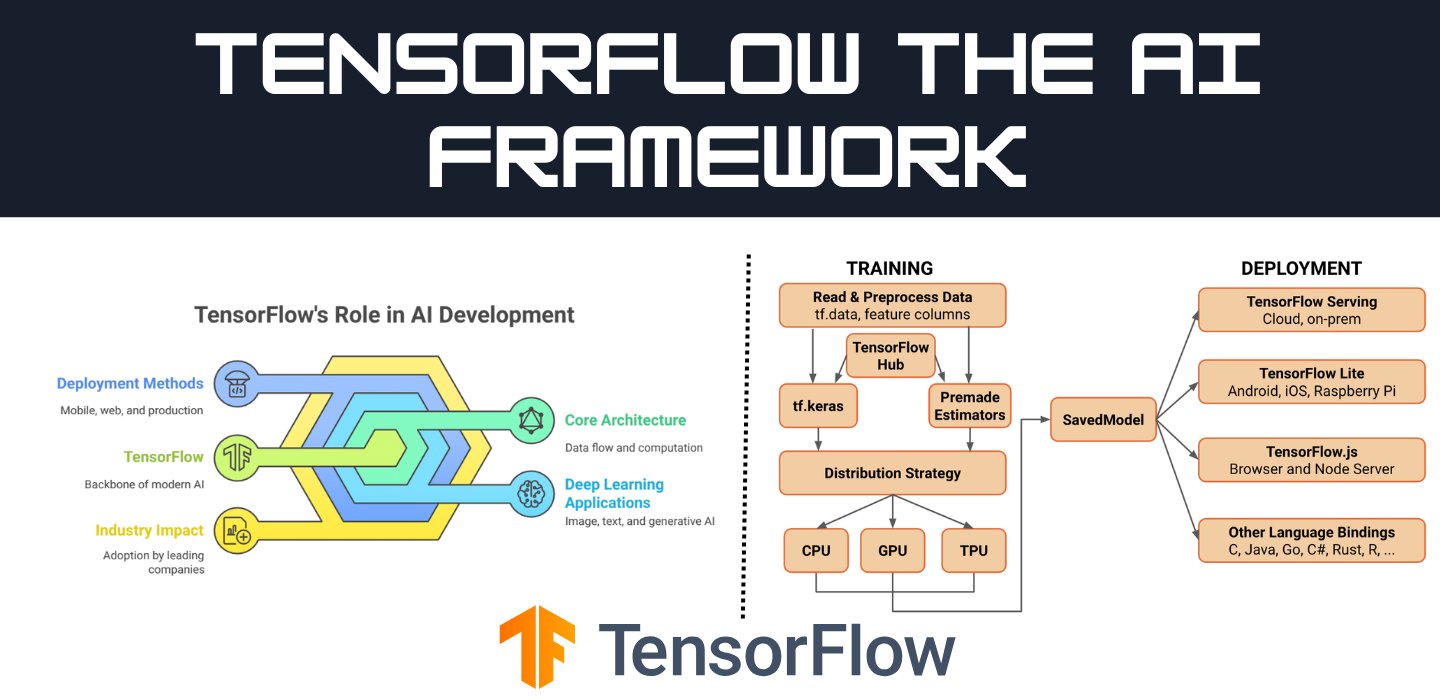Table Of Contents

TensorFlow: The Backbone of Modern AI and Machine Learning
TensorFlow is one of the most powerful and widely used deep learning frameworks today. Developed by Google, it allows developers, researchers, and data scientists to build, train, and deploy AI models at scale. Whether it is image recognition, natural language processing, or generative AI, TensorFlow provides the foundation for creating intelligent applications.
Why TensorFlow?
Before TensorFlow, machine learning was complex, requiring low-level programming for neural networks. TensorFlow changed that by offering a flexible, efficient, and scalable platform. It supports everything from simple linear regression to cutting-edge deep learning architectures.
Key reasons why TensorFlow is the go-to framework:
- Scalability It runs on CPUs, GPUs, and TPUs, making it ideal for both personal projects and enterprise-scale AI solutions.
- Flexibility Developers can use high-level APIs like Keras for quick prototyping or dive into low-level tensor operations for more control.
- Deployment Ready TensorFlow models can be deployed on mobile devices, web applications, cloud platforms, and even edge devices.
- Industry Adoption Companies like Google, Tesla, and OpenAI leverage TensorFlow for tasks ranging from autonomous driving to AI-powered chatbots.
How TensorFlow Works: The Core Architecture
TensorFlow operates using data flow graphs, where computations are represented as nodes in a graph. This structure allows efficient execution across multiple processors, optimizing AI workloads.
Here is how it processes data:
- Tensors: The Building Blocks TensorFlow represents data as multi-dimensional arrays (tensors). Everything in TensorFlow images, text, audio is processed as a tensor.
- Computation Graph The framework creates a computational graph, defining mathematical operations. This makes execution efficient, especially for deep learning.
- Auto-Differentiation TensorFlow automatically calculates gradients during backpropagation, optimizing neural networks efficiently.
- Execution in Sessions Operations in TensorFlow run within a session, which handles resource management and computation scheduling.
Deep Learning with TensorFlow
TensorFlow is widely used for training deep learning models, from simple neural networks to complex architectures.
1. Building Neural Networks
Using TensorFlow and Keras, developers can build and train models with just a few lines of code.
Example:
import tensorflow as tf
from tensorflow import keras
# Define a simple neural network
model = keras.Sequential([
keras.layers.Dense(128, activation='relu', input_shape=(784,)),
keras.layers.Dense(10, activation='softmax')
])
# Compile the model
model.compile(optimizer='adam', loss='sparse_categorical_crossentropy', metrics=['accuracy'])
# Train the model
model.fit(training_data, training_labels, epochs=10) This simplicity is why TensorFlow is so popular among AI developers.
2. Computer Vision & Image Recognition
TensorFlow powers state-of-the-art image classification and object detection models. Pre-trained models like MobileNet, ResNet, and EfficientNet make AI accessible even to those without deep expertise in deep learning.
3. Natural Language Processing (NLP)
From chatbots to language translation, TensorFlow provides powerful NLP tools. Transformers-based models like BERT and GPT have been fine-tuned using TensorFlow, allowing AI to process and generate human-like text.
4. Generative AI and GANs
TensorFlow is also widely used in Generative Adversarial Networks (GANs) and Diffusion Models, which power AI-generated art, synthetic media, and deepfake detection.
TensorFlow Deployment: AI Beyond Research
TensorFlow is not just for research, it is built for production.
- TensorFlow Lite Runs AI models on mobile and embedded devices, optimizing performance without requiring cloud computing.
- TensorFlow.js Enables AI-powered web applications, allowing deep learning models to run directly in the browser.
- TensorFlow Serving Helps deploy AI models at scale in production environments, ensuring real-time inference and scalability.
Challenges of Using TensorFlow
While TensorFlow is powerful, it has its challenges:
- Learning Curve Beginners might find TensorFlow’s low-level operations complex, though Keras simplifies much of the workflow.
- Computational Demand Training large models requires high-end GPUs or TPUs, making cloud computing essential for many projects.
- Debugging Complexity Debugging deep learning models can be tricky, but TensorFlow’s tf.function decorators and TensorBoard visualization tools help track performance.
The Future of TensorFlow and AI
TensorFlow is constantly evolving. With advances in self-supervised learning, multimodal AI, and federated learning, the framework continues to push the boundaries of what AI can achieve. Google’s integration of TensorFlow with AutoML and Vertex AI is making AI development even more accessible.
As AI becomes more embedded in everyday life, TensorFlow remains at the forefront powering everything from smart assistants to AI-driven healthcare innovations.
Final Thoughts
TensorFlow is more than just a framework, it is the backbone of modern AI. It enables developers to experiment, innovate, and deploy deep learning solutions at scale. Whether you are an AI researcher, a software engineer, or a data scientist, understanding TensorFlow is key to building the future of AI.
The question is how will TensorFlow shape the next wave of AI breakthroughs?











